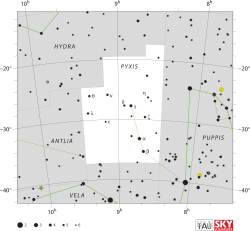Pyxis
| Constellation | |

|
|
| Abbreviation | Pyx |
|---|---|
| Genitive | Pyxidis |
| Pronunciation | /ˈpɪksᵻs/, genitive /ˈpɪksᵻdᵻs/ |
| Symbolism | The compass box |
| Right ascension | 9 |
| Declination | −30 |
| Family | Heavenly Waters |
| Quadrant | SQ2 |
| Area | 221 sq. deg. (65th) |
| Main stars | 3 |
|
Bayer/Flamsteed stars |
10 |
| Stars with planets | 3 |
| Stars brighter than 3.00m | 0 |
| Stars within 10.00 pc (32.62 ly) | 1 |
| Brightest star | α Pyx (3.68m) |
| Nearest star |
Gliese 318 (30.13 ly, 9.24 pc) |
| Messier objects | None |
| Meteor showers | None |
| Bordering constellations |
Hydra Puppis Vela Antlia |
|
Visible at latitudes between +50° and −90°. Best visible at 21:00 (9 p.m.) during the month of March. |
|
Pyxis (/ˈpɪksᵻs/; Greek: box) is a small and faint constellation in the southern sky. Abbreviated from Pyxis Nautica, its name is Latin for a mariner's compass (contrasting with Circinus, which represents a draftsman's compasses). Pyxis was introduced by Nicolas Louis de Lacaille in the 18th century, and is counted among the 88 modern constellations. The constellation is located close to those forming the old constellation of the ship Argo Navis, and in the 19th century astronomer John Herschel suggested renaming Pyxis to Malus, the mast, but the suggestion was not followed. Pyxis is completely visible from latitudes south of 53 degrees north, with its best evening-sky visibility in February and March.
The plane of the Milky Way passes through Pyxis. A faint constellation, its three brightest stars—Alpha, Beta and Gamma Pyxidis—are in a rough line. At magnitude 3.68, Alpha is the constellation's brightest star. It is a blue-white star around 22,000 times as luminous as the Sun. Near Alpha is T Pyxidis, a recurrent nova that has flared up to magnitude 7 every few decades. Three star systems have planets, all discovered by doppler spectroscopy.
...
Wikipedia
